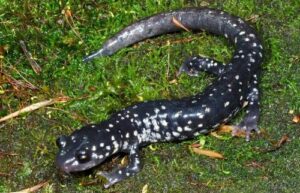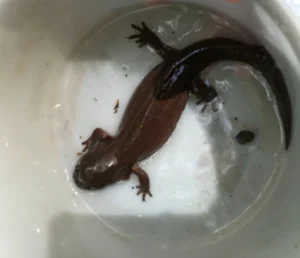Salamanders are small, quiet creatures that come in many shapes, sizes, and colors. Some are bright orange, some have spots or stripes, and many are brown, green, or gray. But one question that often comes up is whether any salamanders are black.
Yes, some salamanders are black or mostly black. Their dark color helps them stay hidden, absorb warmth, or warn predators, but not all salamanders are black, color depends on the species, habitat, and other natural factors.
Which Salamanders Are Black?
There are several kinds of salamanders that are black or mostly black. Some are a solid dark color, while others have spots or markings. A few examples include:
Black Salamander (Aneides flavipunctatus)
This salamander lives in northern California. It has a black or charcoal body covered with small yellow or white spots.
It often hides in damp logs or forest floors, where its dark body helps it blend in with the shadows.
Slimy Salamander (Plethodon glutinosus)
Found across the eastern United States, this salamander has shiny black skin that looks moist or slimy.

It sometimes has tiny white or blue specks. Its slick, dark appearance helps it stay hidden among wet leaves and soil.
Northern Dusky Salamander (Desmognathus fuscus)
This species lives near streams, springs, and moist forest floors. It is usually dark brown to black with lighter speckles or spots

Its coloring helps it disappear against wet rocks and leaf litter.
California Giant Salamander (Dicamptodon ensatus)
One of the largest salamanders in North America, this species lives in cool streams in the Pacific Northwest. It is usually dark brown or black, with some faint lighter markings. Its large size and dark body make it well-suited to shady, flowing water.

Other salamanders may also appear black at times, depending on their age, lighting, or surroundings. In some cases, their color can shift slightly in different conditions, though most keep the same general look throughout their lives.
Why Are Some Salamanders Black?
Dark colors like black are useful for many reasons. They can help salamanders hide, warm up, or stay safe from predators. These benefits often depend on where the salamander lives and how it survives.
- Camouflage in Shady Areas Many salamanders live in forests, under logs, or near streams where light is low. Black coloring helps them stay hidden in dark, wet places. Blending into the background makes it harder for predators like birds, snakes, or mammals to spot them.
- Better Heat Absorption Salamanders are cold-blooded, which means they depend on the environment to control their body temperature. Dark colors absorb heat better than light ones. A black salamander can warm up more quickly in a cool, shady forest, which may help it stay active and alert.
- Warning Colors Some salamanders use a mix of black and bright colors, like yellow or white, to warn predators that they are toxic or taste bad. These bright spots stand out against the black background and tell animals to stay away.
- Protection From Sunlight Although salamanders avoid direct sunlight, they still get some light through tree cover or when moving through open areas. Dark pigmentation may help protect them from harmful rays. This is especially helpful for species that live near the edge of water or in patchy sunlight.
Are Black Salamanders Poisonous?
Most salamanders are not dangerous to people, but some can release toxins through their skin.
These chemicals can taste bad or irritate the mouth and eyes. The toxins help protect them from animals that might try to eat them.
Black salamanders, like the Slimy Salamander, often have sticky skin secretions. These are not deadly but can be unpleasant.
If you handle a salamander, be sure to wash your hands afterward and avoid touching your face or eyes.
Pets like cats or dogs can get sick if they try to eat a toxic salamander. If you have pets, keep them away from wild amphibians.
If you plan to keep a salamander as a pet, make sure to learn about its care and handling first.
Can Salamanders Change Color?
Some salamanders can change their shade slightly, but they do not shift colors like chameleons. The change may happen due to temperature, stress, or moisture. A black salamander might look a little lighter when dry or slightly darker when wet.
Color may also shift with age or season. Young salamanders sometimes look different from adults, and colors can become more or less intense during breeding time. However, most black salamanders stay dark throughout their lives.
Are All Salamanders Dark?
No, salamanders come in many colors. Some are bright red or orange, like the juvenile stage of the Eastern Newt (called an eft). Others are green, yellow, or even blue. Many have bold spots, stripes, or blotches.
For example:
- Spotted Salamanders have black bodies with bright yellow spots.
- Eastern Newts are greenish-brown as adults but bright orange as efts.
- Marbled Salamanders are black with silver or white bands.
- Tiger Salamanders are dark with yellow stripes or blotches.

While black is common, especially in shaded forests or near water, it is just one of many color patterns in salamanders.
Conclusion
Yes, many salamanders are black or mostly black. Black skin helps them blend into shaded, moist places like forest floors and stream banks. It also helps them stay warm and can warn predators to stay away.
While not all salamanders are black, dark colors are common in species that live in cool, damp environments. From the shiny Slimy Salamander to the large California Giant Salamander, black-bodied species are an important part of forests and streams.
If you see a black salamander, look for clues like its size, markings, and where it lives. Most are harmless to humans, though some can release mild toxins. It’s best to observe them gently and leave them where they belong.
Hi, my name is Ezra Mushala, i have been interested animals all my life. I am the main author and editor here at snakeinformer.com.

